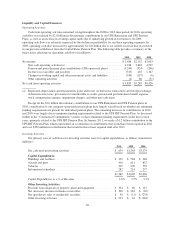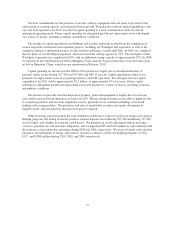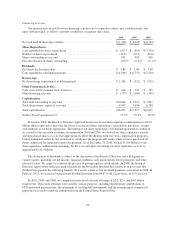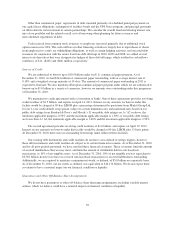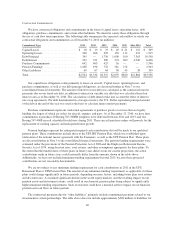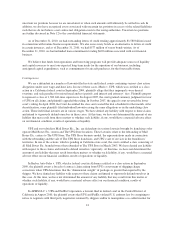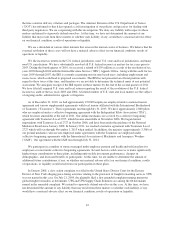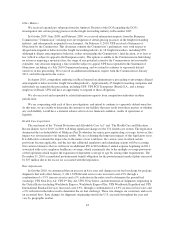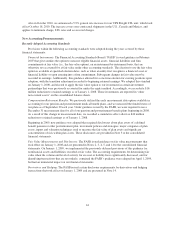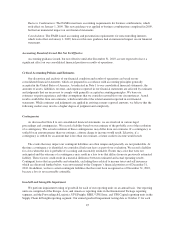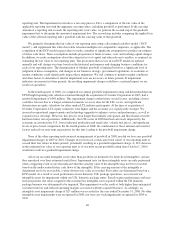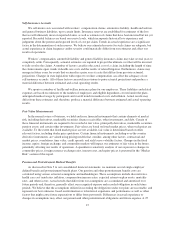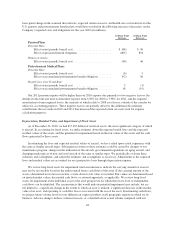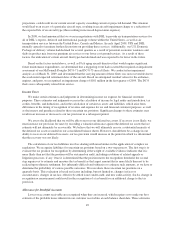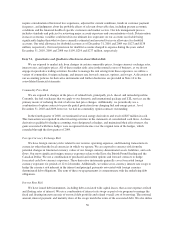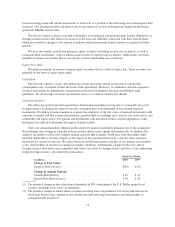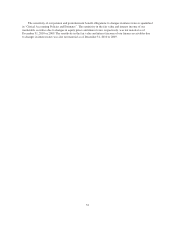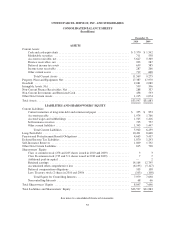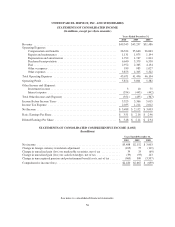UPS 2010 Annual Report Download - page 58
Download and view the complete annual report
Please find page 58 of the 2010 UPS annual report below. You can navigate through the pages in the report by either clicking on the pages listed below, or by using the keyword search tool below to find specific information within the annual report.reporting unit. The impairment test involves a two-step process. First, a comparison of the fair value of the
applicable reporting unit with the aggregate carrying values, including goodwill, is performed. If the carrying
amount of a reporting unit exceeds the reporting unit’s fair value, we perform the second step of the goodwill
impairment test to determine the amount of impairment loss. The second step includes comparing the implied fair
value of the affected reporting unit’s goodwill with the carrying value of that goodwill.
We primarily determine the fair value of our reporting units using a discounted cash flow model (“DCF
model”), and supplement this with observable valuation multiples for comparable companies, as applicable. The
completion of the DCF model requires that we make a number of significant assumptions to produce an estimate
of future cash flows. These assumptions include projections of future revenue, costs and working capital changes.
In addition, we make assumptions about the estimated cost of capital and other relevant variables, as required, in
estimating the fair value of our reporting units. The projections that we use in our DCF model are updated
annually and will change over time based on the historical performance and changing business conditions for
each of our reporting units. The determination of whether goodwill is impaired involves a significant level of
judgment in these assumptions, and changes in our business strategy, government regulations, or economic or
market conditions could significantly impact these judgments. We will continue to monitor market conditions
and other factors to determine if interim impairment tests are necessary in future periods. If impairment
indicators are present in future periods, the resulting impairment charges could have a material impact on our
results of operations.
In the fourth quarter of 2008, we completed our annual goodwill impairment testing and determined that our
UPS Freight reporting unit, which was formed through the acquisition of Overnite Corporation in 2005, had a
goodwill impairment of $548 million. This impairment charge resulted from several factors, including a lower
cash flow forecast due to a longer estimated economic recovery time for the LTL sector, and significant
deterioration in equity valuations for other similar LTL industry participants. At the time of acquisition of
Overnite Corporation, LTL equity valuations were higher and the economy was significantly stronger. We
invested in operational improvements and technology upgrades to enhance service and performance, as well as
expand service offerings. However, this process took longer than initially anticipated, and thus financial results
had been below our expectations. Additionally, the LTL sector in 2008 had been adversely impacted by the
economic recession in the U.S., lower industrial production and retail sales, volatile fuel prices, and significant
levels of price-based competition. By the fourth quarter of 2008, the combination of these internal and external
factors reduced our near term expectations for this unit, leading to the goodwill impairment charge.
None of the other reporting units incurred an impairment of goodwill in 2008, nor did we have any goodwill
impairment charges in 2009 or 2010. Changes in our forecasts could cause book values of our reporting units to
exceed their fair values in future periods, potentially resulting in a goodwill impairment charge. A 10% decrease
in the estimated fair value of our reporting units as of our most recent goodwill testing date (October 1, 2010)
would not result in a goodwill impairment charge.
All of our recorded intangible assets other than goodwill are deemed to be finite-lived intangibles, and are
thus amortized over their estimated useful lives. Impairment tests for these intangible assets are only performed
when a triggering event occurs that indicates that the carrying value of the intangible may not be recoverable
based on the undiscounted future cash flows of the intangible. If the carrying amount of the intangible is
determined not to be recoverable, a write-down to fair value is recorded. Fair values are determined based on a
DCF model. As a result of weak performance in our domestic U.K. package operations, we reviewed our
intangible assets for impairment within our U.K. domestic package entity. Based on prior performance and near-
term projections, the value assigned to the customer list intangible asset acquired within the UK domestic
package business was determined to be impaired. This impairment was the result of both higher than anticipated
customer turnover and reduced operating margins associated with the acquired business. Accordingly, an
intangible asset impairment charge of $27 million was recorded for the year ended December 31, 2008. No other
intangible asset impairments were recognized in 2008, nor were any such impairments recognized in 2009 or
2010.
46


